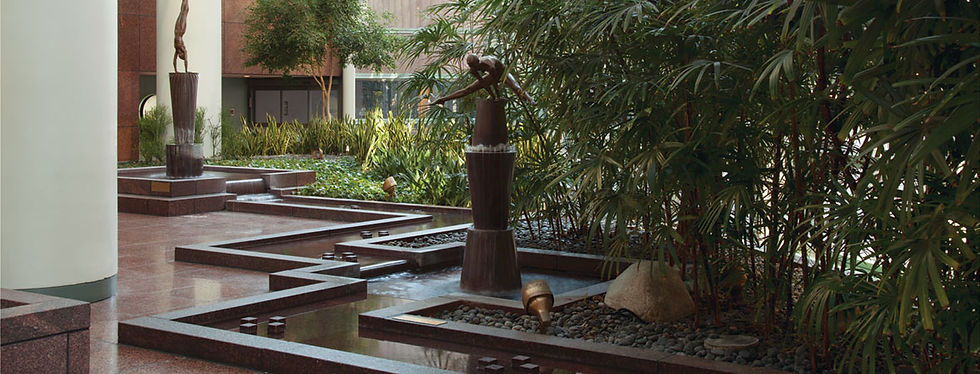Grand Hope Park
- jeff04393
- Sep 20, 2017
- 3 min read

By Les Sechler, ASLA
In the middle of downtown Los Angeles is a verdant 2.5 acre oasis, filled with bougainvillea covered pergolas, shady enclaves, whimsical sculptures and a children’s playground. Designed by landscape architect and visionary Lawrence Halprin, Grand Hope Park was commissioned in the early 1980s by the Los Angeles Community Redevelopment Agency (“CRA”). Intended to be an initial component of its proposed redevelopment of the southern section of downtown, today the park serves as the gateway to the rapidly growing South Park residential, cultural, and commercial area. Halprin, who was working on the Bunker Hill Steps at the time, was awarded the design contract.
One of Halprin’s concerns during planning phase was that the neighborhood envisioned by the CRA would take years to densify, critical to the success of any public space. Coincidentally, The Fashion Institute of Design and Merchandising (FIDM) was working with the CRA searching for a new location for its main campus. Halprin, recognizing that an instant population of 3000+ students on the park would activate it like almost nothing else could, lobbied the CRA to allow FIDM to acquire the northeast corner of the property for its new campus. The southeast corner had already been designated as a housing site, but Halprin knew that having the large student population directly on the park morning until evening would jump start the park’s chance for success.

FIDM hired Jerde Partnership as architects for its new campus, and Jerde and Halprin worked together to integrate the college with the park. According to FIDM founder and President, Tonian Hohberg, Halprin designed many of the spaces with campus events in mind. He encouraged Jerde to modify their design to include a covered arcade along the building’s entire park side creating a gracious, European style transition from building to outdoor urban space.
The park was planned as a series of “outdoor rooms” each delineated by trees, sculptures, fountains and walkways. Its center is occupied by a large lawn with a curvilinear path and edged by pergolas, the children’s play area, and public art.

The southern section of the park is more structured featuring paved terraces and one of Halprin’s interactive water features. Schematic drawings indicate that Halprin also specified locations for the art, including installations by Lita Albuquerque (Celestial Source Fountain for the sunken water court), Adrian Saxe (wildlife figures), Raul Guerrero (Hope Street Fountain and decorative stenciling on pergolas), Gwynn Murrill (coyotes, hawk, snake), Tony Berlant, and Ralph McIntosh. The iconic Clock Tower, with its whimsical mosaics, was designed by Halprin. The CRA commissioned musical compositions by John Carter, Michael McNabb, and Ushio Torikai to mark each hour of the day.

An eight-foot fence that surrounds the park was a controversial last minute addition, due partially to concerns about vandalism to the public art and to the climate of fear generated by the 1992 riots in the city. It is open sunrise to sunset 365 days a year.
Grand Hope Park was inaugurated in 1993. At the time it was said to be the first major park built in downtown Los Angeles since Central Park (now Pershing Square) opened in 1870. Construction costs were $4.8 million with $390,000 going to public art installations throughout the site. It is the last downtown Los Angeles landscape designed by Lawrence Halprin and is also the final piece in the Los Angeles Open Space Network – an ambitious plan to connect downtown Los Angeles through a series of open landscapes. The other sites are Wells Fargo Center, Bunker Hill Steps and the Los Angeles’ Central Library’s Maguire Gardens.
The Cultural Landscape Foundation: Landscape as Catalyst: Lawrence Halprin's Legacy and Los Angeles




Comments